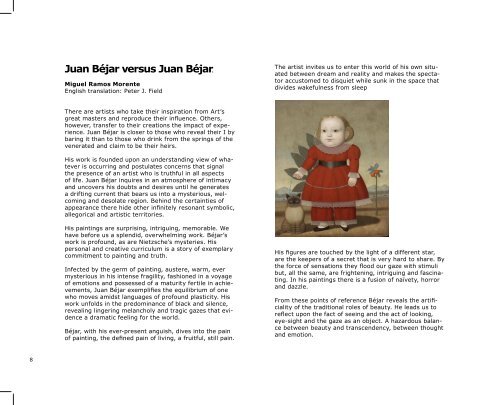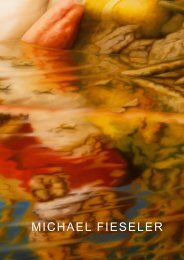Juan Béjar Juan Béjar - thomas punzmann gallery
Juan Béjar Juan Béjar - thomas punzmann gallery
Juan Béjar Juan Béjar - thomas punzmann gallery
You also want an ePaper? Increase the reach of your titles
YUMPU automatically turns print PDFs into web optimized ePapers that Google loves.
8<br />
<strong>Juan</strong> <strong>Béjar</strong> versus <strong>Juan</strong> <strong>Béjar</strong>.<br />
Miguel Ramos Morente<br />
English translation: Peter J. Field<br />
There are artists who take their inspiration from Art’s<br />
great masters and reproduce their influence. Others,<br />
however, transfer to their creations the impact of experience.<br />
<strong>Juan</strong> <strong>Béjar</strong> is closer to those who reveal their I by<br />
baring it than to those who drink from the springs of the<br />
venerated and claim to be their heirs.<br />
His work is founded upon an understanding view of whatever<br />
is occurring and postulates concerns that signal<br />
the presence of an artist who is truthful in all aspects<br />
of life. <strong>Juan</strong> <strong>Béjar</strong> inquires in an atmosphere of intimacy<br />
and uncovers his doubts and desires until he generates<br />
a drifting current that bears us into a mysterious, welcoming<br />
and desolate region. Behind the certainties of<br />
appearance there hide other infinitely resonant symbolic,<br />
allegorical and artistic territories.<br />
His paintings are surprising, intriguing, memorable. We<br />
have before us a splendid, overwhelming work. <strong>Béjar</strong>’s<br />
work is profound, as are Nietzsche’s mysteries. His<br />
personal and creative curriculum is a story of exemplary<br />
commitment to painting and truth.<br />
Infected by the germ of painting, austere, warm, ever<br />
mysterious in his intense fragility, fashioned in a voyage<br />
of emotions and possessed of a maturity fertile in achievements,<br />
<strong>Juan</strong> <strong>Béjar</strong> exemplifies the equilibrium of one<br />
who moves amidst languages of profound plasticity. His<br />
work unfolds in the predominance of black and silence,<br />
revealing lingering melancholy and tragic gazes that evidence<br />
a dramatic feeling for the world.<br />
<strong>Béjar</strong>, with his ever-present anguish, dives into the pain<br />
of painting, the defined pain of living, a fruitful, still pain.<br />
The artist invites us to enter this world of his own situated<br />
between dream and reality and makes the spectator<br />
accustomed to disquiet while sunk in the space that<br />
divides wakefulness from sleep<br />
His figures are touched by the light of a different star,<br />
are the keepers of a secret that is very hard to share. By<br />
the force of sensations they flood our gaze with stimuli<br />
but, all the same, are frightening, intriguing and fascinating.<br />
In his paintings there is a fusion of naïvety, horror<br />
and dazzle.<br />
From these points of reference <strong>Béjar</strong> reveals the artificiality<br />
of the traditional roles of beauty. He leads us to<br />
reflect upon the fact of seeing and the act of looking,<br />
eye-sight and the gaze as an object. A hazardous balance<br />
between beauty and transcendency, between thought<br />
and emotion.<br />
<strong>Béjar</strong> makes a refined and harmonious exercise of drawing,<br />
shows a prodigious sense of composition, lavishes<br />
technique and quality in determining with radical precision<br />
the use of impasto and glaze. In his latest work,<br />
exhibited at the Contempo Gallery in Rotterdam, his<br />
new treatment of landscape is surprising. Noteworthy is<br />
its position in the central plane of the board, the surface<br />
of which he subjects to different intensities and layering<br />
of the material, allowing us to glimpse the marvellous<br />
ability that is characteristic of his aesthetic inventions.<br />
The painter is strongly drawn towards the portraits of<br />
deepest Spain left to us by Goya, Solana and Zuloaga<br />
and others of religious and court subjects conceived<br />
by the supreme genius of Velázquez, Zurbarán, Murillo,<br />
Carreño and other Spanish masters. He himself is an<br />
acknowledged exponent of contemporary Spanish figurative<br />
plastic art. He also confesses his admiration for<br />
American Naïve Painting, those 19th-century paintings<br />
of disturbing simplicity. The prodigious force of its painting<br />
irradiates a creative innocence.<br />
<strong>Béjar</strong>, inspired by Kafka’s fruitful solitude, draws the<br />
syllables of dreams, the vast darkness of anguish, the<br />
stifling stillness of disconsolation. <strong>Béjar</strong> names the heart<br />
of pain, wandering gardens, irremediable collapse. A<br />
spiral of silence envelopes the broken clouds of dreams<br />
and floods the presentiment of autumn, leaving the town<br />
waves away.<br />
Along the highways of his paintings pass silent anatomies,<br />
versions of a humankind that is distorted or continually<br />
disturbed. Unspeakable characters who survey<br />
the slow limit of their hips, stunned by the extreme whiteness<br />
that bursts from their thighs. Disturbed bosoms<br />
of maidens wrapped in old gold and luminous transparencies.<br />
Immense eyes stuck fast in the trembling of<br />
their disorientation and now denuded of all gazes. Hands<br />
that freeze from absence, red lips that say your name as<br />
they insinuate squalls. Startling prehensile fingers, belts<br />
of light, frozen angles, decomposed jazmines, oranges,<br />
violets, cherries, plant-shoots that spring up in the green<br />
moistness of a head of hair.<br />
The artist bleeds dry in each of his paintings, surrounded<br />
by landscapes broken by the whistling of sadness, birds<br />
that forgot to take to wing, cats trapped in rootlessness,<br />
beribboned grasshoppers, landscapes set far back, bees,<br />
drifting insects, butterflies, asfixiating snakes, blue-dyed<br />
flowers, ribbons, tulle, hoops, diabolos, parts of inhospitable<br />
dead stations, white bootees for feet that will never<br />
tread fresh grass.<br />
The artist has founded a kingdom in a delirium of forms,<br />
inhabited by a chorus of beings <strong>Béjar</strong> revives in each<br />
painting and envelopes in the rain of bewilderment, a<br />
sweet rain of appearances that does not vitalize the soil



